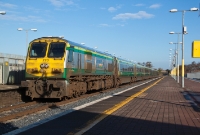Newbridge
The large Co.Kildare commuting town of Newbridge was first served by rail in August 1846, when the Great Southern & Western Railway opened their line from Dublin to Carlow. Until 1994, Newbridge had a sparse passenger service. Following the introduction of the 'Arrow' commuter services, the station has acquired more stopping services. A new bay platform for terminating services from Dubln Heuston was recently constructed on the down side of the station. The 1840s station buildings are typical of the type built by the GSWR on the line towards Carlow, which feature Tudor style architecture. The main buildings, including the large water tower, are located on the down side, while on the up is an attractive GSWR canopy. The lattice footbridge is attached to the main building. The goods yard at Newbridge was located at the north end of the station on the down side. Although goods services ceased in 1976, the sidings remained in situ until 1994, when the platform and car park were extended. The small stone built goods shed was also demolished. Newbridge signal cabin was located at the south end beyond the narrow road overbridge, and was demolished after CTC signalling was introduced in 1976.

















